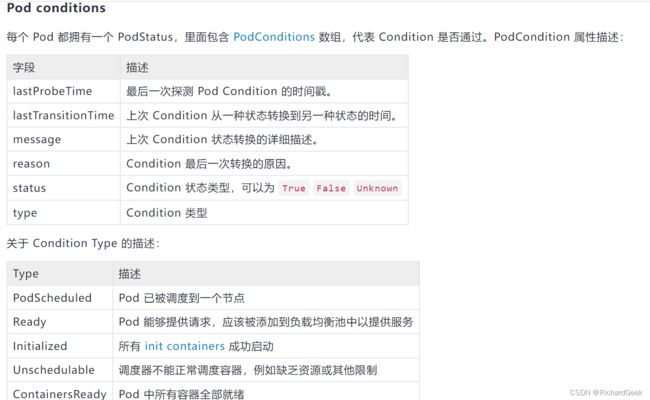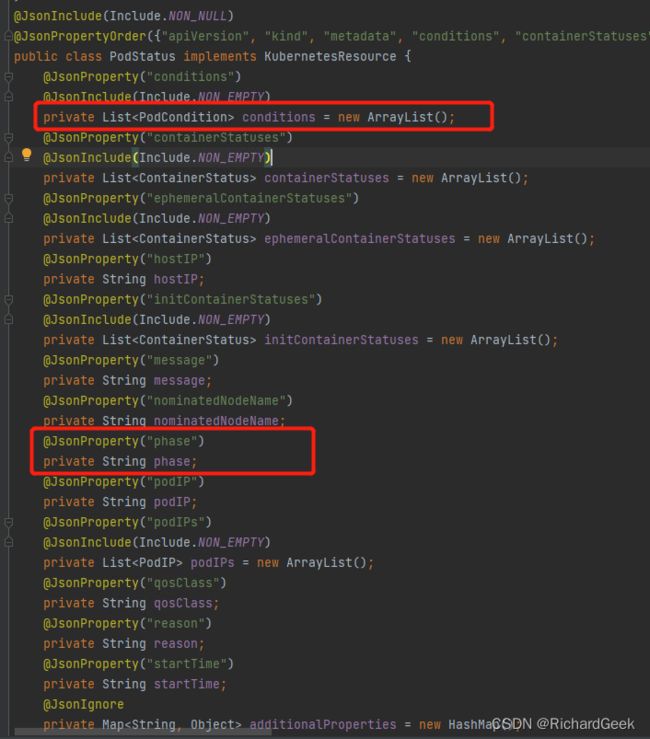Pod 的 phase 和 conditions 的区别
目录
前言
PodStatus对象
pod 的 phase 字段
phase 作用
有哪些 phase
pod 的 conditions 字段
pod 有了 phase,为什么还要有 conditions
pod 的 conditions 的作用
pod 的 conditions 分类
conditions设计原则
condition字段内容
前言
Kubernetes 中, pod 从创建到成功运行会分别处于不同的阶段,每个阶段又分为不同的状态,本文将简单介绍这个环节。
在 K8S 源码中,使用了 PodPhase 这个变量定义这几个阶段信息,如下图所示:
- 运行中(Pod Running):该 Pod 已经绑定到了一个节点上,Pod 中所有的容器都已被创建。至少有一个容器正在运行,或者正处于启动或重启状态。
- 等待中(Pod Pending): 创建 Pod 的请求已被 Kubernetes 系统接受,但有一个或者多个容器镜像尚未创建。可能的原因有,写数据到etcd,调度,pull镜像,启动容器这四个阶段中的任何一个阶段,pending 伴随的事件通常会有:ADDED, Modified这两个事件的产生。等待时间包括调度 Pod 的时间和下载镜像的时间,这可能需要花些时间。
- 正常终止(Pod Succeeded):pod中的所有的容器已经正常的自行退出,并且k8s永远不会自动重启这些容器,一般会是在部署job的时候会出现。
- 异常停止(Pod Eailed):Pod 中的所有容器都已终止了,并且至少有一个容器是因为失败终止。也就是说,容器以非0状态退出或者被系统终止。
- 未知状态(Pod Unkonwn):出于某种原因,无法获得Pod的状态,通常是由于与Pod主机通信时出错。
实际上还有一中状态Terminating,在代码和文档中都没有说明,但却是存在。这种情况出现杂无法获取所在主机的资源情况,一直在尝试建立连接。
PodStatus对象
Pod 有一个 PodStatus 对象,其中包含一个 PodConditions 数组。Pod 可能通过也可能未通过其中的一些状况测试。
pod 的 phase 字段
phase 作用
用于描述、查看、分析 pod 当前处于什么状态。
有哪些 phase
通常情况下,在 pod 的生命周期中,每个 pod 会处于 5 个不同的 phase:pending,running,succeed,failed,unknown。同一时间,1 个 pod 只能处于 1 个 phase。
- 当 pod 刚被创建时,它处于 pending 这个 phase,等待被调度;
- 如果 pod 中的一个或多个 container 处于运行状态时,那么 pod 就处于 running phase;
- 如果 pod 中的 container 不是被设置为无限运行下去的情况下(比如执行定时任务或一次性任务),且 container 运行结束,那么 pod 处于 succeed phase;
- 反之,如果 pod 中的 container 不是被设置为无限运行下去的情况下(比如执行定时任务或一次性任务),且 container 运行失败,那么 pod 处于 failed phase;
- 如果 pod 所在 node 上的 kubelet 出现故障或意外,而停止向 Kubernetes API server 报告它所在 node 上的 pod 的状态时,那么此时该 node 上的 pod 就处于 unknown phase;
pod 的 conditions 字段
pod 有了 phase,为什么还要有 conditions
因为 pod 的 phase 比较简单的描述了 pod 处于哪个具体情况,但是没有明确说明具体原因。
pod 的 conditions 的作用
用于描述 1 个 pod 当前是否处于哪个 phase,以及处于该 phase 的原因。及作为一个辅助手段,详细的展示 pod 的状态信息,用于问题排查分析时提供更多依据。同一时间,1 个 pod 可能处于多个 conditions。
Pod 的 conditions 表示了 Pod 的一些条件,是一个数组。pod的 conditions 状况默认有4个,它是由Pod controller生成,里面包含一些 Pod 必须满足的条件,只有所有的条件为 True 时,Pod 才可以提供服务。
pod 的 conditions 分类
通常分为 4 个 conditions:PodScheduled,Initialized,ContainersReady,Ready。见名知意:
- PodScheduled:意味着 pod 是否已经被调度到某个 node;
- Initialized:Pod 的 init containers 是否全部完成;
- ContainersReady:pod 中的所有 container 是否全部就绪;但这并不意味着 pod 也 ready;
- Ready:pod 是否就绪;只有 pod 中的所有 container 就绪,且 pod 的 readiness probe 也完成了,意味着 pod 可以对外提供服务了,才是 ready 状态。
Pod Lifecycle | KubernetesThis page describes the lifecycle of a Pod. Pods follow a defined lifecycle, starting in the Pending phase, moving through Running if at least one of its primary containers starts OK, and then through either the Succeeded or Failed phases depending on whether any container in the Pod terminated in failure.Whilst a Pod is running, the kubelet is able to restart containers to handle some kind of faults. Within a Pod, Kubernetes tracks different container states and determines what action to take to make the Pod healthy again.![]() https://kubernetes.io/docs/concepts/workloads/pods/pod-lifecycle/#pod-conditions
https://kubernetes.io/docs/concepts/workloads/pods/pod-lifecycle/#pod-conditions
conditions设计原则
conditions寄居于资源对象的status字段中,与status其他字段值一样都用来表示资源的状态。 不过conditions的设计初衷是提供一种通用的数据结构表示资源的状态,它通常能够提供比status其他字段更详细的信息(比如状态切换时间、更新时间),conditions实际上是一种扩展机制,外部监控程序可以根据conditions无差别地监控各种资源的状态,而不必过分关注资源对象status中的其他信息。
通常status.conditions字段类型为切片,切片中的每个元素表示资源的某个状态,该状态由特定的控制器更新,比如Deployment控制器会更新deployment对象的status.conditions信息。conditions作为扩展机制,它还支持第三方控制器增加新的状态。通常status.conditions中的信息由控制器根据资源的status其他字段计算出来。
condition字段内容
通常一个condition必须包含type(状态类型)和status(状态值)两个信息。在Kubernetes v1.19版之前,关于condition并没有统一的标准,导致众多API都自行定义了condition。比如:
- Deployment使用的Condition为
type DeploymentCondition struct; - Pod使用的Condition为
type PodCondition struct;
庆幸的是,在Kubernetesv1.19版本社区提供了一个标准的condition类型定义,由于兼容性考虑,Kubernetes既有的API不一定能采用这一标准类型,但对于后续新增的API将会使用这一标准类型,并且笔者建议用户设计的CRD扩展也应使用这一标准类型。
标准的condition类型定义如下所示:
type ConditionStatus string
const (
ConditionTrue ConditionStatus = "True"
ConditionFalse ConditionStatus = "False"
ConditionUnknown ConditionStatus = "Unknown"
)
type Condition struct {
// 类型(使用驼峰风格),如”Available“。
Type string
// 状态(枚举值:”True“、”False“和”Unknown“)。
Status ConditionStatus
// 观察到的generation。
// 如果ObservedGeneration 比metada.generation小,说明不是最新状态。
// +optional
ObservedGeneration int64
// 上次变化时间
LastTransitionTime Time
// 状态变化原因(使用驼峰风格),如”NewReplicaSetAvailable“
Reason string
// 描述信息,如”Deployment has minimum availability“
Message string `json:"message" protobuf:"bytes,6,opt,name=message"`
}


